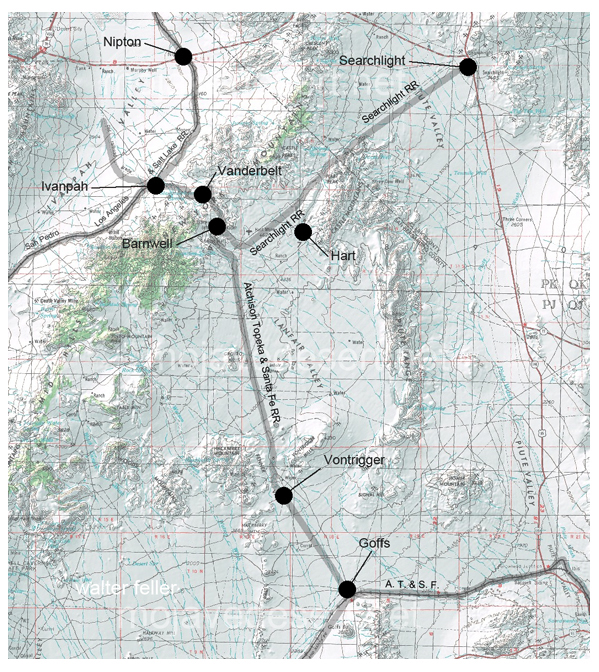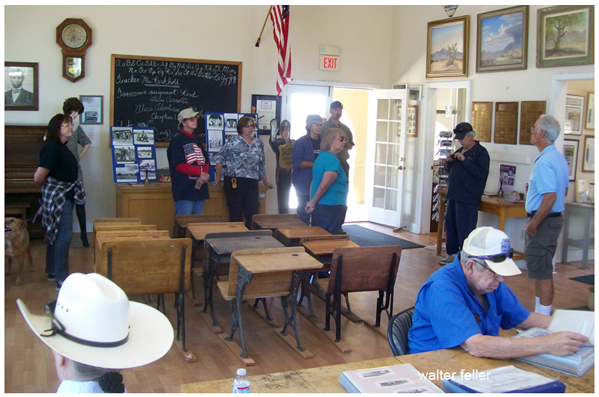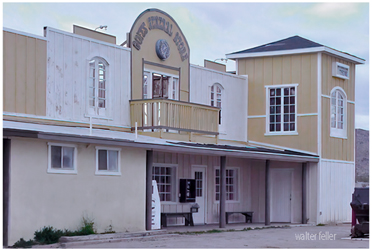History of Goffs
Schoolhouse

The Goffs Schoolhouse is a one-story, wood framed, Mission/Spanish Revival building with a square plan, a flat roof with unique red tin tiles covering the eaves, and a porch surrounding two sides. The walls are finished with stucco, and the foundation and porch floors are built of concrete. The interior is divided into three rooms: an 800-square-foot classroom, with an entry hall and two smaller rooms. The building was designed by well-known San Bernardino architect Anthony Beimer. Constructed in 1914, it was built to be the school and social center for the 1,000-square-mile Goffs School District. It is located in the town of Goffs, which was founded in the late 19th century as a railroad junction in the vast east Mojave Desert. Today, the schoolhouse, still standing on its original site, serves as the museum and headquarters of the Mojave Desert Heritage and Cultural Center. The property is in excellent condition and retains significant integrity for listing in the National Register of Historic Places.

The Goffs Schoolhouse is significant at the local level under Criterion A in the area of education. It was the only elementary school serving the Goffs School District, which encompassed 1,000 square miles of rural San Bernardino County, during the years 1914 to 1937. The Goffs School District was incorporated into the Needles School District in 1937, and students from Goffs transferred to the school in Essex, approximately 15 miles southwest. The Goffs Schoolhouse is also significant under Criterion A in the area of social history, for its role as an important community center and as a branch of the county library. Finally, the Schoolhouse is significant under Criterion A in the area of defense as it was used as a canteen for U.S. Army soldiers training in the desert from 1942 to 1944.
Early Mining and Railroad Period in Goffs

In 1854, Amiel Weeks Whipple became the first person to travel in a wheeled vehicle through the east Mojave. Three years later, Lieutenant Edward F. Beale led the U.S. Army Camel Corps on an expeditionary force that set out to create a route across the desert southwest. These two expeditions would be the U.S. government's first attempts to link southern California to the east, and resulted in a wagon trail that would become known as the Mojave Road. However, the Mojave road was a trail not suitable for a railroad because it went straight over the Providence Mountains at steep grades. When the Southern Pacific Railway was extended from Needles to Barstow in 1883, the 'rails were laid fifteen miles south of the Mojave Road. Stagecoaches followed the railroad's tracks on their journeys to southern California.
Goffs, California was founded on March 19, 1883 as a station for the railroad. In 1884, Atlantic and Pacific Railway (A&P) operated the line through Goffs under a lease agreement with the Southern Pacific. At that time, Goffs Station consisted of a turntable and the limited structures needed for dropping off railroad cars for the delivery of freight. Goffs did not become a permanent settlement until the 1890s, when gold was discovered in the New York Mountains.
By 1892 a boom was on, and Goffs was the nearest railroad shipping point for the mining camp of Vanderbilt. Tent businesses sprang up in Goffs, and the busy mines attracted the usual entrepreneurs. One of these, Isaac C. Blake, was involved in building the Needles Reduction Works on the Colorado River. In order to haul ore to his mill, Blake built a short line railroad directly from Goffs to Vanderbilt in 1893. Called the Nevada Southern Railway, it connected to the A&P rails at Goffs. However, Blake's project — using the Nevada Southern to bring ores from the desert mines to his mill in Needles on a daily basis — failed for several reasons, and the Nevada Southern went into receivership in 1894. It was reorganized as the California Eastern Railway in 1895.

Three Santa Fe Subsidiaries - Railroads around the Mojave National Preserve
In 1901 the Santa Fe Railroad acquired substantial stock in the California Eastern and constructed an extension. The Santa Fe purchased the rest of the California Eastern in 1902, and the short line became part of the Santa Fe. At that time, the Santa Fe decided to improve Goffs, including a new depot and a deep well at the site. An additional extension was constructed in 1907 to accommodate the mining boom in Searchlight, which had begun in 1897. The short line operated until 1923, when it was abandoned.
All of this activity changed the face of Goffs. Tent businesses became a permanent business district by the early 1900s. Most of the land on either side of the tracks belonged to the Santa Fe Railroad. In fact, there was only one plot of private land, 160 acres immediately north of the Santa Fe right-of-way and depot grounds. William Seibert filed a homestead entry for this property in 1898. In 1907, prominent businessman Henry Peace Ware purchased the Seibert homestead. Eventually, the Goffs Schoolhouse would be built on a portion of this land.
Creation of the Goffs School District
The 1910 census listed 58 persons in Goffs. The details of this census reflected the importance of the railroad: 42 of the 58 persons counted in the census were living in Goffs because they were connected to the railroad. The others ran local businesses — the hotel, the general store — and were employed by Wells Fargo, in mining, and as general laborers. In addition, many miners, prospectors, and ranchers lived in the area..jpg)
The 58 people counted in the census included 11 children, either of school age or approaching that age. Within one year, the Santa Fe Railroad transferred some Mexicar section workers to Goffs. These workers arrived with their families and settled in the town. Soon there were enough children to justify the building of a school. Therefore, in December 1910 the San Bernardino County Board of Supervisors approved a petition from the residents of Goffs, requesting that the Goffs School District be created. The district was formally incorporated in January 1911.
The first schoolhouse, built by Henry Peace Ware, was a typical simple wood frame structure, which the school district rented from Ware for $12.00 per month. The citizens of Goffs were proud to have a school and were not satisfied with a rented building. Their landlord also believed that the district should have a permanent building that belonged to it alone. So in 1913, Ware donated one square acre of land to the district. The Board of Trustees then hired San Bernardino architect Anthony Beimer and contractor William Thomas Waer to design and build the school. The board appropriated $2300 to complete the project.
The Goffs Schoolhouse was built primarily with volunteer labor, with the county providing the materials. This was common for the time, as the schoolhouse served the community in many ways. For instance, the Goffs Schoolhouse was a community center and a branch library, as well as a venue for religious services, elections, and monthly dances. However, at the time of construction, this building was designated primarily as a one-room school for grades one through eight, all children to be taught by one teacher. Classes commenced in the fall of 1914.
The total number of students enrolled at the Goffs School averaged 29 per year for 24 of the 26 years of the school's existence (attendance data for school years 1916-17 and 1935-36 are missing). One teacher supervised all the children in one room — a common instructional method of the time.
According to Dennis Casebier, author of Goffs and Its Schoolhouse, "One consistent characteristic of the Goffs School was that throughout its existence the enrollment included a large percentage of Mexican children — 50% on the average." These students were, for the most part, the children of the Mexican railroad workers who began coming to Goffs in 1910. Reminiscent of today's schools, there were children in every class who did not speak English, and most teachers were not bilingual. Therefore, since children of all levels were taught in one classroom in Goffs, older bilingual students assumed the role of teacher's assistants, communicating with those children who did not speak English.
One of the unique aspects of the Goffs Schoolhouse was the size of its one classroom - - 800 square feet of unobstructed space. In addition, it possessed a magnificent hardwood floor — just right for dances. Throughout much of its history, dances and other social events were held in the schoolroom as often as once a month.
A most illuminating oral history interview covering the education and social history years is that of Inez (Pineda) Cisneros, who attended the Goffs School with her sister Frances and brother Joe from 1932 to 1937. Their father worked for the Santa Fe Railroad as a laborer. According to Mrs. Cisneros, her brother was born in Goffs in 1923 and "Goffs was then a thriving little town." As a student, Mrs. Cisneros remembers particularly saying the Pledge of Allegiance on the schoolhouse porch each morning prior to class, and trading lunches with non-Mexican students, who became ver^i fond of her mother's homemade chicken burritos. Once a year the students would have a "Tacky Day," a special day when the children could come to school dressed in their worst — almost like dress-up, which children love to do. Mrs. Cisneros also recalls something called an "outhouse raffle" for boys and girls (she doesn't explain this) and taffy pulls in which the children took part.
Recesses and lunches broke up the school day. The two broad schoolhouse porches were particularly suited for outdoor play in both hot and cold weather. The school sat in the center of a one-acre lot, large enough for the children to play baseball, a favorite game. In addition, the yard contained typical playground equipment — a set of rings for swinging, a maypole, and a glider or seesaw.
Memories of social events held at the school are particularly vivid. Square dancing ("That was the center of the recreation."), Saturday night dances, religious services, Bible study, men's club functions, lectures, and poetry recitations were some of the events held at the Goffs School. Dorothy Overson Burrier, who moved to Goffs about 1936, remembers attending a dance and the eighth grade graduation at the schoolhouse. According to Mrs. Cisneros, "Anything that was important...was done at the school. It happened at the school. The school was the center of everything."
Goffs continued to prosper. During World War I, the town once again became a mining center, this time for tungsten, a strategic war material. From 1910 through the war years, hundreds of people moved into the area, filing claims for homesteads along the short line railroad. But what became essential to the post-war survival of Goffs and its schoolhouse was business spurred by the automobile, and the road that was to be called the Main Street of America, Route 66.
The Mother Road and Its Relationship with Goffs

In 1913, the road alongside the Santa Fe Railroad from the California coast to New Mexico was designated as part of the National Old Trails Road. The National Old Trails Road was a configuration of routes from Baltimore to Los Angeles that included portions of what would become U.S. 1, U.S. 240, U.S. 40, U.S. 56, U.S. 85 and U.S. 66. The Auto Club of Southern California promoted the National Old Trails Road as the most convenient route to Los Angeles, and their efforts were not wasted. Goffs already hac well-developed railroad facilities and was a major center for mining and ranching activities in the east Mojave Desert. By the time the Goffs schoolhouse was built, automobile traffic was coming through Goffs on a regular basis. By 1916 an average of 40 vehicles per day passed through. Businesses built due to road travel included three garages, a free overnight campground, and the Wayside Inn. As the mining and railroad industries declined in the early 1920s, the National Old Trails Road became the lifeblood of the Goffs community. In the meantime, the U.S. Secretary of Agriculture, pressured by state highway officials, created an organized highway numbering system of significant U.S. roads. Cyrus Stevens Avery, a state highway representative from Oklahoma, proposed a 2,400-mile road from Chicago to Los Angeles. The proposition was approved in 1925, and in November 1926, the National Old Trails Road was designated U.S. Highway 66.

According to records kept by the Daggett quarantine station (which monitors horticultural products entering California), 5412 automobiles traveled into southern California via Route 66 in July 1927 alone. By July 1928, the number was up to 6214, and 6742 in 1930. Prospects for Goffs as a major highway town were promising until 1931, when the California Highway Department decided to reroute U.S. 66 for financial reasons. The original alignment of route 66, which followed the Santa Fe railroad, curved around the Piute Mountains, south of Goffs. By building a new highway through the mountains, the California Highway Department could save $245,000 by shortening the route by six miles. A newly rerouted and paved Route 66 opened in December 1931, bypassing Goffs.
The "Ghosting" of Goffs
As a result of the rerouting of Route 66, local businesses either folded or relocated to the new stretch of road. With World War I long over, mining at a relaxed pace, and the homesteading boom finished, Goffs quieted down considerably. There was a brief period in the early 1930s when Goffs became an "Air Navigation Site," with runways, maintenance buildings, and a tower to accommodate emergency landings of transcontinental mail planes. However, as the field was intended only for irregular, unscheduled emergency landings, there was no reason for people to relocate here. Despite the town's ill fortunes, the Goffs School continued to operate. It drew students from the towns on Route 66. In addition, the children of Mexican railroad workers continued to attend the school. In the 1930s the school district began drawing on a much larger area for students, which required a bus and driver. Residents argued that the Goffs Schoolhouse, by this time over 20 years old, required expensive repairs, and that the school should be more centrally located in Essex. In 1936 the Goffs School District ceased to exist, and was incorporated into the Needles School District. The last classes in the Goffs Schoolhouse were held in June 1937. In December 1937 the Goffs Schoolhouse property was conveyed back to Henry Peace Ware.Goffs and the Army Desert Training Center

Although it ceased to be a school, the Goffs Schoolhouse remained in service to its community. From 1940-1942, the Goffs Schoolhouse property was a dairy and a residence/store for the Bill Campbell family. From April 1942 to April 1944 it also served the country, for it became an Army canteen for the Desert Training Center (later the California-Arizona Maneuver Area). The DTC/CAMA encompassed an area largei than England, covering parts of southern California, southern Nevada, and northeasterr Arizona. It was the biggest Army training area in the United States, and the only desert training center. This unique Army training theater of operations included 7 major camps, 9 airdromes, 42 landing strips, and 5 major hospitals. Nearly 200,000 troops trained for Europe and Asia at any one time.

Herb Bender, a railroad brakeman who passed through Goffs quite frequently, remembers vividly the Goffs Schoolhouse during the Army period: "...[M]y only recollection of the school house...was having been over there once or twice, and visited them, and got something to eat when it was a big PX for the Army." Mr. Bender further recalls that "it was one of the largest PX's for our United States government during the war," and that it was operated solely by soldiers. The sheer number of soldiers who lived and worked temporarily in the vicinity of Goffs during the war, and who patronized the Army canteen in the Schoolhouse, is clearly portrayed in Mr. Bender's reminiscence.
Inez (Pineda) Cisneros also remembers the Army in Goffs: "Tents? As far as the eye could see. I mean everywhere." She also recalls how the Army tore down everything surrounding Goffs. "But here sat the schoolhouse. They used it."
Goffs Schoolhouse After World War II

After the fighting in North Africa and Italy during World War II concluded, the Goffs Schoolhouse served as a home/store/cafe for Tom and June Craig (1944-1945). The building was then occupied on and off as a residence until 1954, when it was abandoned. Between 1954 and 1982, people camped and took up occasional residence in the building. However, by 1982, the Schoolhouse was in a generally dilapidated state due to vandalism.
At this time, Jim and Bertha Wold purchased the building and surrounding land. They shored up the schoolhouse roof, added a small kitchen, replaced the windows, and remodeled the school into a home, where they lived until 1990. At that time, they sold the building and land to Dennis and Jo Ann Casebier.
The Casebiers and assorted volunteers restored the building to its original 1914 incarnation as a schoolhouse. The Goffs Schoolhouse now belongs to the Mojave Desert Heritage and Cultural Association, for which it serves as a museum, cultural center, and research facility for the eastern Mojave Desert.
Schoolhouse
Early Mining and Railroad
Goffs School District
The "Ghosting" of Goffs
Army Desert Training Center
After World War II Adapted from:
USDI/NPS NRHP Registration Form
Goffs Schoolhouse - Goffs, California
Aug 27, 2001

General store - circa 2001
